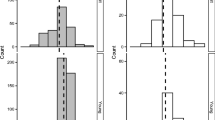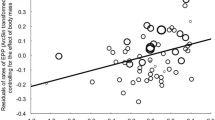Abstract
The good genes hypothesis and the genetic compatibility hypothesis are the two main hypotheses that focus on the genetic benefit that a female can gain through her choice of a mate. We tested the two hypotheses on extra-pair mating in the great tit, Parus major. We found that female great tits choose males on the basis of breast stripe width, which is in accordance with the good genes hypothesis. Although females chose less related extra-pair males, the evidence for female choice for compatible males was overall weak. However, our data suggest a post-copulatory mechanism of inbreeding avoidance. The observed individual inbreeding coefficient, F, was similar for within-pair offspring (WPO) and extra-pair offspring (EPO). The observed individual F of WPO was lower than the expected individual F, whereas the observed F of EPO was similar to what was expected. These results highlight the importance of processes after copulation for the outcome of female mate choice. Our study shows that in a system with apparent pre-copulatory female choice for good genes, a post-copulatory mechanism may still promote the production of offspring that carry compatible genes.




Similar content being viewed by others
References
Bensch S, Hasselquist D, von Schantz T (1994) Genetic similarity between parents predicts hatching failure: nonincestuous inbreeding in great reed warbler. Evolution 48:317–326
Bensch S, Price T, Kohn J (1997) Isolation and characterization of microsatellite loci in a Phylloscopus warbler. Mol Ecol 6:91–92
Blakey JK (1994) Genetic evidence for extra-pair fertilizations in a monogamous passerine, the great tit Parus major. Ibis 136:457–462
Blomqvist D, Andersson M, Küpper C, Cuthill IC, Kis J, Lanctot RB, Sandercock BK, Szekely T, Wallander J, Kempenaers B (2002) Genetic similarity between mates and extra-pair parentage in three species of shorebirds. Nature 419:613–615
Bouwman KM, Burke T, Komdeur J (2006) How female reed buntings benefit from extra-pair mating behaviour: testing hypotheses through patterns of paternity in sequential broods. Mol Ecol 15:2589–2600
Bretman A, Wedell N, Tregenza T (2004) Molecular evidence of post-copulatory inbreeding avoidance in the field cricket Gryllus bimaculatus. Proc R Soc Lond B 271:159–164
Charmantier A, Blondel J, Perret P, Lambrechts MM (2004) Do extra-pair paternities provide genetic benefits for female blue tits Parus caeruleus? J Avian Biol 35:524–532
Colegrave N, Kotiaho JS, Tomkins JL (2002) Mate choice or polyandry: reconciling genetic compatibility and good genes sexual selection. Evol Ecol Res 4:911–917
Crawly MJ (2002) Statistical computing: an introduction to data analysis using S-plus. Wiley, England
Dawson DA, Hanotte O, Grieg C, Stewart IK, Burke T (2000) Polymorphic microsatellites in the blue tit Parus caeruleus and their cross-species utility in 20 songbird families. Mol Ecol 9:1941–1944
Delhey K, Jhonson A, Peters A, Andersson S, Kempenaers B (2003) Paternity analysis reveals opposing selection pressures on crown coloration in the blue tit (Parus caeruleus). Proc R Soc Lond B 270:2057–2063
Foerster K, Delhey K, Johnson A, Lifjeld JT, Kempenaers B (2003) Females increase offspring heterozygosity and fitness through extra-pair matings. Nature 425:714–717
Foerster K, Valcu A, Johnson A, Kempenears B (2006) A spatial genetic structure and effects of relatedness on mate choice in a wild bird population. Mol Ecol 15:4555–4567
Freeman-Gallant CR, Weelwright NT, Meiklejohn KE, Sollecito SV (2006) Genetic similarity, extrapair paternity, and offspring quality in savannah sparrows (Passeruculus sandwichensis). Behav Ecol 17:952–958
Goldstein DB, Schlötterer C (1999) Microsatellites. Oxford University Press, New York
Griffin AS, West SA (2003) Kin discrimination and the benefit of helping in cooperatively breeding vertebrates. Science 302:634–636
Griffith SC, Owens IPF, Thuman KA (2002) Extra pair paternity in birds: a review of interspecific variation and adaptive function. Mol Ecol 11:2195–2212
Gullberg A, Tegelström H, Gelter HP (1992) DNA fingerprinting reveals multiple paternity in families of great and blue tits (Parus major and P. caeruleus). Hereditas 117:103–108
Hansson B, Jack L, Christians JK, Pemberton JM, Åkesson M, Westerdahl H, Bensch S, Hasselquist D (2007) No evidence for inbreeding avoidance in a great reed warbler population. Behav Ecol 18:157–164
Hasselquist D, Bensch S, von Schantz T (1996) Correlation between male song repertoire, extra-pair paternity and offspring survival in the great reed warbler. Nature 381:229–232
Hatchwell BJ, Ross DJ, Fowlie MK, McGowan A (2001) Kin discrimination in cooperatively breeding long-tailed tits. Proc R Soc Lond B 268:885–890
Jennions MD, Petrie M (2000) Why do females mate multiply? A review of the genetic benefits. Biol Rev 75:21–64
Kawano KM (2003) Isolation of polymorphic microsatellite markers in the great tit (Parus major minor). Mol Ecol Notes 3:314–315
Keller LF, Waller DM (2002) Inbreeding effects in wild populations. Trends Ecol Evol 17:230–241
Kempenares B, Verheyen GR, van den Broeck M, Burke T, Van Broeckhoven C, Dhondt AA (1992) Extra-pair paternity results from female preference for high-quality males in the blue tit. Nature 357:494–496
Kempenaers B, Verheyren GR, Dhondt AA (1997) Extrapair paternity in the blue tit (Parus caeruleus): female choice, male characteristics, and offspring quality. Behav Ecol 8:481–492
Kokko H, Ots I (2006) When not to avoid inbreeding. Evolution 60:467–475
Komdeur J, Hatchwell BJ (1999) Kin recognition: function and mechanism in avian societies. Trends Ecol Evol 14:237–241
Komdeur J, Richardson DS, Burke T (2004) Experimental evidence that kin discrimination in the Seychelles warblers based on association and not on genetic relatedness. Proc R Soc Lond B 271:963–969
Lemel J, Wallin K (1993) Status signaling, motivational condition and dominance—an experimental study in the great tit, Parus major L. Anim Behav 45:549–558
Lubjuhn T, Strohbach S, Brün J, Gerken T, Epplen J (1999a) Extra-pair paternity in great tits (Parus major)—a long-term study. Behaviour 136:1157–1172
Lubjuhn T, Gerken T, Brün J, Epplen JT (1999b) High frequency of extra-pair paternity in the Coal Tit. J Avian Biol 30:229–233
Lynch M, Ritland K (1999) Estimation of pairwise relatedness with molecular markers. Genetics 152:1753–1766
Marshall RC, Buchanan KL, Catchpole CK (2003) Sexual selection and individual genetic diversity in a songbird. Proc R Soc Lond B (suppl.) 270: S248–S250
Masters BS, Hicks BG, Johnson LS, Erb LA (2003) Genotype and extra-pair paternity in the house wren: a rare-male effect? Proc R Soc Lond B 270:1393–1397
Mays HL, Hill GE (2004) Choosing mates: good genes versus genes that are a good fit. Trends Ecol Evol 19:554–559
McCullagh P, Nelder JA (1989) Generalized linear models, 2nd edn. Chapman and Hall, London
Neff BD, Pitcher TE (2005) Genetic quality and sexual selection: an integrated framework for good genes and compatible genes. Mol Ecol 14:19–38
Norris K (1990) Female choice and the evolution of the conspicuous plumage coloration of monogamous male great tits. Behav Ecol Sociobiol 26:129–138
Norris K (1993) Heritable variation in a plumage indicator of viability in male great tits Parus major. Nature 362:537–539
Oh KP, Badyaev AV (2006) Adaptive genetic complementarity in mate choice coexists with selection for elaborate sexual traits. Proc R Soc Lond B 273:1913–1919
Otter K, McGregor PK, Terry AM, Burford FRL, Peake TM, Dabelsteen T (1999) Do female great tits (Parus major) assess males by eavesdropping? A field study using interactive song playback. Proc R Soc Lond B 266:1305–1309
Otter KA, Stewart IRK, McGregor PK, Terry AMR, Dabelsteen T, Burke T (2001) Extra-pair paternity among great tits Parus major following manipulation of male signals. J Avian Biol 32:338–344
Pizzari T, Levlie H, Cornwallis CK (2004) Sex-specific, counteracting responses to inbreeding in a bird. Proc R Soc Lond B 271:2115–2121
Ritland K (1996) Estimators for pairwise relatedness and individual inbreeding coefficients. Genet Res 67:175–185
Schmoll T, Dietrich V, Winkel W, Epplen JT, Lubjuhn T (2003) Long-term fitness consequences of female extra-pair matings in a socially monogamous passerine. Proc R Soc Lond B 270:250–264
Schmoll T, Quellmalz A, Dietrich V, Winkel W, Epplen JT, Lubjuhn T (2005a) Genetic similarity between pair mates is not related to extrapair paternity in the socially monogamous coal tit. Anim Behav 69:1013–1022
Schmoll T, Dietrich V, Winkel W, Epplen JT, Schurr F, Lubjuhn T (2005b) Paternal genetic effects on offspring fitness are context dependent within the extrapair mating system of a socially monogamous passerine. Evolution 59:645–657
Senar JC, Pascual J (1997) Keel and tarsus length may provide a good predictor of avian body size. Ardea 85:269–274
Simmons LW, Beveridge M, Wedell N, Tregenza T (2006) Postcopulatory inbreeding avoidance by female crickets only revealed by molecular markers. Mol Ecol 15:3817–3824
Stewart IR, Hanschu RD, Burke T, Westneat DF (2006) Tests of ecological, phenotypic, and genetic correlates of extra-pair paternity in the house sparrow. Condor 108:399–413
Strohbach S, Curio E, Bathen A, Epplen JT, Lubjuhn T (1998) Extrapair paternity in the great tit (Parus major): a test of the “good genes” hypothesis. Behav Ecol 9:388–396
Tang-Martinez Z (2001) The mechanisms of kin discrimination and the evolution of kin recognition in vertebrates: a critical re-evaluation. Behav Processes 53:21–40
Thuman KA, Griffith SC (2005) Genetic similarity and the nonrandom distribution of paternity in a genetically highly polyandrous shorebird. Anim Behav 69:765–770
Tregenza T, Wedell N (2000) Genetic compatibility, mate choice and patterns of parentage. Mol Ecol 9:1013–1027
Verboven N, Mateman AC (1997) Low frequency of extra-pair fertilizations in the great tit Parus major revealed by DNA fingerprinting. J Avian Biol 28:231–239
von Schantz T, Göransson G, Andersson G, Fröberg I, Grahn M, Helgée A, Wittzell H (1989) Female choice selects for a viability-based male trait in pheasants. Nature 337:166–169
Wilson JD (1992) A re-assessment of the significance of status signaling in populations of wild great tits, Parus major. Anim Behav 43:999–1009
Zeh JA, Zeh DW (2001) Reproductive mode and the genetic benefits of polyandry. Anim Behav 61c:1051–1063
Acknowledgments
We are indebted to the members of our laboratory for their encouragement. We especially thank O. K. Mikami for his comments on this manuscript. We also thank the staff of the Nature Reserve of Fukuoka City and the staff of the Wild Bird Society of Japan in Mt. Aburayama for their cooperation with our investigation in the field. English used in this manuscript was revised by Miss K. Miller (Royal English Language Center, Fukuoka, Japan).
Author information
Authors and Affiliations
Corresponding author
About this article
Cite this article
Kawano, K.M., Yamaguchi, N., Kasuya, E. et al. Extra-pair mate choice in the female great tit Parus major: good males or compatible males. J Ethol 27, 349–359 (2009). https://doi.org/10.1007/s10164-008-0126-8
Received:
Accepted:
Published:
Issue Date:
DOI: https://doi.org/10.1007/s10164-008-0126-8




